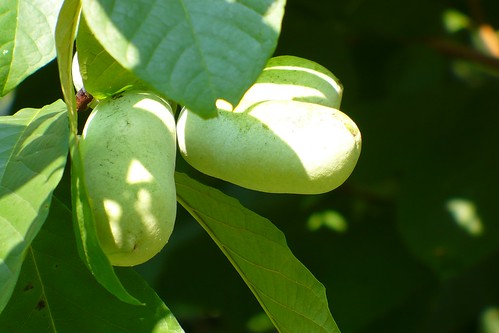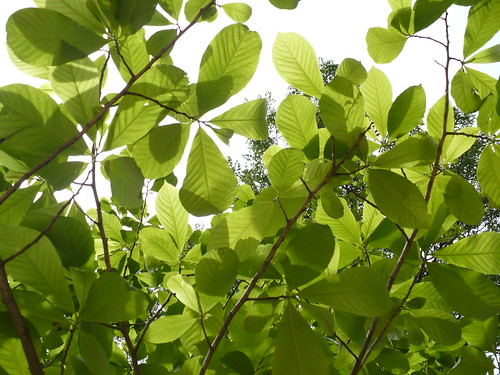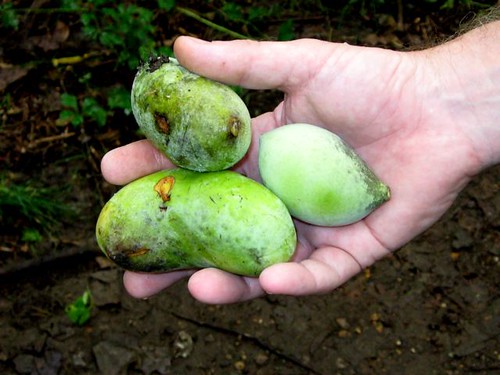 The paw paw is the largest fruit of any native plant in our area. And you can eat it. And they should be ripening over the next few weeks. Need I say more?
The paw paw is the largest fruit of any native plant in our area. And you can eat it. And they should be ripening over the next few weeks. Need I say more?Paw paw fruits have a green skin and soft yellow flesh, and are typically about the size of two golf balls stacked together. The flavor has been described as similar to many different things -- banana, custard, mango -- but really it has its own taste. Pawpaws can have an unusual aftertaste that limit me to enjoying one or two fruits. But those few fruits are such a treat when they come from the forest!
 Paw Paw (Asimina triloba) is the northernmost member of the Annonaceae family, which includes other tropical fruits such as the soursop. I had always thought they were related to papaya, but apparently it is in name (and somewhat appearance) only.
Paw Paw (Asimina triloba) is the northernmost member of the Annonaceae family, which includes other tropical fruits such as the soursop. I had always thought they were related to papaya, but apparently it is in name (and somewhat appearance) only.Immature paw paw trees are abundant in the forests in and around Washington, DC. When young, they look more like an understory shrub than a fruit-bearing tree. You will often see groves of them growing together, because they can spread by underground roots. Their large, broad leaves (6 to 12 inches long) alternate along the branches and have a distinctive smell when they are rubbed or broken. (It reminds me of kerosene.)
 It seems only a small fraction of the abundant small trees actually become large enough to bear fruit. They also fruit more when the trees that allowed them to thrive as shade-loving seedlings die and fall, leaving the pawpaws with more sun. Under the right conditions, they can bear quite a crop. Paw paws attract not only humans but are also a good food source for racoons, opossums, and squirrels.
It seems only a small fraction of the abundant small trees actually become large enough to bear fruit. They also fruit more when the trees that allowed them to thrive as shade-loving seedlings die and fall, leaving the pawpaws with more sun. Under the right conditions, they can bear quite a crop. Paw paws attract not only humans but are also a good food source for racoons, opossums, and squirrels.  For harvesting, you want the fruit to be quite soft; the best way to find ripe fruits is to shake the tree and go after the ones that fall down. The skin will be green even when ripe.
For harvesting, you want the fruit to be quite soft; the best way to find ripe fruits is to shake the tree and go after the ones that fall down. The skin will be green even when ripe.In the wild: We seem to find the most large, fruit bearing trees along the Potomac flood plain. Look for breaks in the tree canopy where pawpaws may be getting more sun. We've seen numerous fruits recently (not yet ripe) on trees in the Carderock area and at Scott's Run...and even a few in Rock Creek Park.
 In your yard: Pawpaws were once cultivated by Native Americans, and Thomas Jefferson is said to have planted them at Monticello - so you'd be in good company if you want to try to grow one. They're supposed to be easy to start from seed. You might have the best luck with seed collected from racoon or opossum scat. However, that presages a challenge to getting the fruit from your trees -- the raccoons may beat you to them.
In your yard: Pawpaws were once cultivated by Native Americans, and Thomas Jefferson is said to have planted them at Monticello - so you'd be in good company if you want to try to grow one. They're supposed to be easy to start from seed. You might have the best luck with seed collected from racoon or opossum scat. However, that presages a challenge to getting the fruit from your trees -- the raccoons may beat you to them.Like the photos in this post? Mouse over for credits; a click takes you to the photographer on Flickr.


